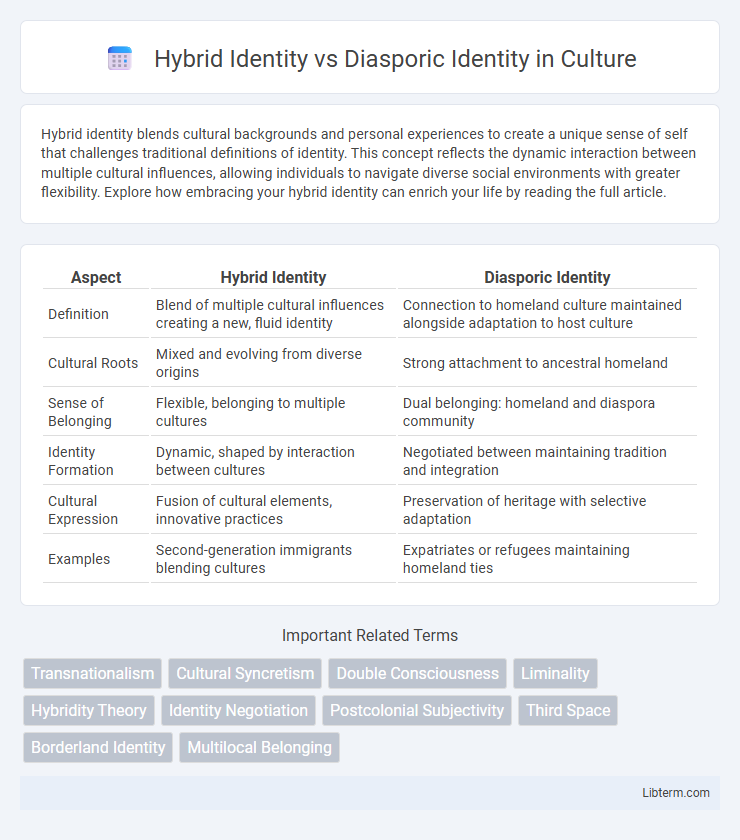Hybrid identity blends cultural backgrounds and personal experiences to create a unique sense of self that challenges traditional definitions of identity. This concept reflects the dynamic interaction between multiple cultural influences, allowing individuals to navigate diverse social environments with greater flexibility. Explore how embracing your hybrid identity can enrich your life by reading the full article.
Table of Comparison
| Aspect | Hybrid Identity | Diasporic Identity |
|---|---|---|
| Definition | Blend of multiple cultural influences creating a new, fluid identity | Connection to homeland culture maintained alongside adaptation to host culture |
| Cultural Roots | Mixed and evolving from diverse origins | Strong attachment to ancestral homeland |
| Sense of Belonging | Flexible, belonging to multiple cultures | Dual belonging: homeland and diaspora community |
| Identity Formation | Dynamic, shaped by interaction between cultures | Negotiated between maintaining tradition and integration |
| Cultural Expression | Fusion of cultural elements, innovative practices | Preservation of heritage with selective adaptation |
| Examples | Second-generation immigrants blending cultures | Expatriates or refugees maintaining homeland ties |
Defining Hybrid Identity
Hybrid identity emerges from the blending of multiple cultural, ethnic, or social influences, creating a unique, multifaceted sense of self that transcends traditional boundaries. It reflects the dynamic interaction between local and global experiences, often manifesting in language, customs, and values that coexist within an individual. Unlike diasporic identity, which centers on connections to a homeland and collective memory, hybrid identity emphasizes fluidity, negotiation, and the ongoing redefinition of identity across diverse contexts.
Understanding Diasporic Identity
Diasporic identity reflects the complex sense of belonging experienced by individuals living outside their ancestral homeland while maintaining strong cultural, social, and emotional ties to their origins. This identity is shaped by transnational connections, collective memory, and ongoing negotiation between assimilation and cultural preservation, often resulting in a dynamic and fluid sense of self. Unlike hybrid identity, which blends elements from multiple cultures into a new, cohesive identity, diasporic identity emphasizes enduring loyalty and connection to one's original community despite geographical dispersion.
Historical Origins of Both Concepts
Hybrid identity originates from postcolonial theory, emphasizing the blending of cultures and identities arising from colonization, migration, and globalization since the late 20th century. Diasporic identity traces back to ancient forced migrations and exile experiences, such as the Jewish and African diasporas, highlighting the collective memory and cultural retention of displaced communities. Both concepts address identity formation through displacement but differ in their historical context and focal points--hybrid identity stresses cultural fusion, while diasporic identity centers on belonging and memory.
Key Theoretical Perspectives
Hybrid identity is often conceptualized through Homi Bhabha's theory of cultural hybridity, emphasizing the creative and dynamic merging of cultures that challenges fixed identities. Diasporic identity draws heavily on Stuart Hall's framework, highlighting identity as a continuous process influenced by history, displacement, and collective memory within transnational contexts. Both perspectives underscore fluidity and multiplicity but differ as hybrid identity stresses cultural blending, while diasporic identity foregrounds the tensions of migration and belonging.
Cultural Adaptation and Change
Hybrid identity reflects the dynamic blending of cultural elements from diverse backgrounds, enabling individuals to navigate and integrate multiple cultural frameworks effectively. Diasporic identity centers on maintaining a connection to the ancestral culture while adapting to the host society, often resulting in a dual sense of belonging marked by cultural negotiation and transformation. Both identities underscore cultural adaptation as a continuous process of change, involving selective assimilation, preservation, and innovation within evolving social contexts.
Identity Negotiation Processes
Hybrid identity involves the dynamic blending of multiple cultural identities, requiring constant negotiation between differing norms, values, and social expectations. Diasporic identity negotiation centers on preserving heritage while adapting to the host culture, often balancing collective memory with contemporary experiences. Both processes engage in dialogical identity construction, where individuals actively reconcile internal and external influences to form coherent self-representations.
Impacts on Community and Belonging
Hybrid identity fosters a dynamic sense of community by blending multiple cultural influences, creating inclusive spaces that enhance belonging among diverse groups. Diasporic identity emphasizes connections to a homeland, often reinforcing collective memory and solidarity within dispersed populations. Both identities impact social cohesion by shaping how individuals relate to their communities and negotiate belonging in multicultural environments.
Challenges and Opportunities in Identity Formation
Hybrid identity presents challenges such as negotiating multiple cultural norms and coping with conflicting societal expectations, which complicates self-definition in multicultural environments. Diasporic identity involves the struggle to maintain connection with ancestral heritage while adapting to a host culture, creating opportunities for enriched cultural expression and resilience. Both identities offer unique chances for intercultural dialogue and innovation in identity formation, despite confronting issues of belonging and cultural fragmentation.
Case Studies: Hybrid vs. Diasporic Experiences
Case studies of hybrid identity reveal individuals navigate multiple cultures simultaneously, blending traditions and adapting to diverse social contexts, resulting in fluid and dynamic self-perceptions. Diasporic identity case studies emphasize a strong connection to homeland heritage, collective memory, and intergenerational transmission of cultural values, often shaped by displacement and migration experiences. Comparative analyses highlight how hybrid identities emphasize multicultural integration while diasporic identities prioritize preserving ancestral roots, each reflecting unique responses to globalization and transnationalism.
Future Directions in Identity Studies
Future directions in identity studies emphasize the dynamic interplay between hybrid identity and diasporic identity, exploring how globalization and digital connectivity reshape self-perception and cultural affiliation. Researchers are increasingly employing interdisciplinary approaches, integrating sociology, anthropology, and digital humanities to examine identity fluidity and transnational experiences. Advances in AI-driven ethnography and big data analytics offer new methodologies to map evolving identity narratives across diverse diasporic communities and hybrid cultural formations.
Hybrid Identity Infographic

 libterm.com
libterm.com